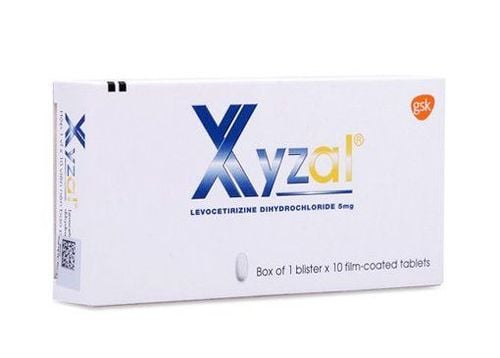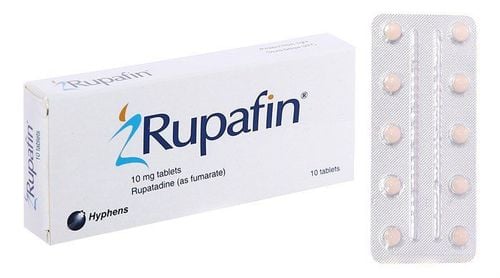This is an automatically translated article.
Fexofenadine is a long-acting antihistamine used to treat allergies, with little sedative effect. This is also the main active ingredient in the drug Usaallerz 120.
1. What is Usaallerz?
The composition of each film-coated tablet Usaallerz 120 contains the active ingredient Fexofenadin hydrochloride with a concentration of 120 mg and a system of excipients including: Corn starch, Pregelatinized starch, Lactose, Croscarmellose sodium, Colloidal anhydrous silica, Talc, Magnesium stearate, Opadry II white, Red iron oxide, Yellow iron oxide just enough for 1 tablet. Fexofenadine hydrochloride is an active ingredient in the group of antihistamines. Fexofenadine is a metabolite of terfenadine, which is also an antihistamine with selective peripheral H1-receptor antagonistic activity. Fexofenadine inhibits antigen-induced bronchoconstriction in susceptible guinea pigs and inhibits the secretion of histamine from peritoneal mast cells in rats. 1-adrenergic alpha receptor blocker.Fexofenadine has little sedation or other CNS effects, it does not cross the blood-brain barrier.
2. What are the uses of Usaallerz?
Seasonal Allergic Rhinitis: Usaallerz treats the symptoms of seasonal allergic rhinitis in adults and in children 12 years of age and older including:
Red/itchy eyes, watery eyes; stuffy nose, runny nose, sneezing; Itchy mouth, itchy throat, ears and face; Usaallerz is also used to treat idiopathic chronic urticaria.
3. Contraindications of the drug Usaallerz
Usaallerz drug is contraindicated for people with hypersensitivity to fexofenadine or any ingredient of Usaallerz drug.
4. Dosage of the drug Usaallerz
Dosage of Usaallerz in seasonal allergic rhinitis and chronic idiopathic urticaria:
Adults and children 12 years of age and older: The recommended dose of Usaallerz is 60mg/time, orally. 2 times daily or 120 - 180mg orally once a day with a full glass of water. The recommended starting dose of Usaallerz for patients with impaired renal function is 60 mg of Fexofenadine orally once daily.
5. Side effects of the drug Usaallerz
In controlled clinical studies, the incidence of adverse events in the Fexofenadine group was similar to that in the placebo group. The incidence of adverse events of Usaallerz was not related to the dose of Fexofenadine and was similarly not related to age, sex, or race.
Common side effects of the drug Usaallerz (rate ≥ 1/100):
Side effects on the nervous system: drowsiness, fatigue, headache, insomnia, dizziness; Side effects on the digestive system: nausea, indigestion; Other side effects of Usaallerz: viral infections, menstrual cramps, upper respiratory tract infections... Side effects of Usaallerz are uncommon (1/1000 ≤ occurrence rate < 1/100):
Side effects of the drug Usaallerz on the nervous system: nervousness, fear, sleep disturbances (nightmares, insomnia); Side effects on the digestive system: dry mouth, abdominal pain. Rare side effects of Usaallerz (incidence <1/1000):
Skin side effects: Skin rash, urticaria, itching; Side effects causing hypersensitivity reactions: angioedema, chest tightness, dyspnea, flushing, anaphylaxis. Inform the doctor of any adverse effects if the patient experiences while using Usaallerz.
6. Precautions and notes when using the drug Usaallerz
Fexofenadine in Usaallerz has no adverse cardiovascular effects, but it is still necessary to carefully monitor drug reactions when using fexofenadine for people at cardiovascular risk or with prolonged QT interval. The physician should adjust the dose appropriately when administering the initial dose of Usaallerz to patients with renal impairment because of the increased bioavailability and half-life of Usaallerz in these patients. Care should be taken when choosing the dose of Usaallerz and monitoring renal function for the elderly because this group of subjects often has physiological decline in renal function. The safety and effectiveness of Usaallerz in children younger than 6 months have not been established. Usaallerz should be discontinued at least 24-48 hours before conducting an intradermal antigen test.
7. Effect of drug Usaallerz on pregnancy and lactation
Because there are not enough controlled studies in pregnant women, Usaallerz should be used during pregnancy only when the benefit to the mother outweighs the risk to the fetus.
It is not known whether fexofenadine is excreted in breast milk, so caution should be exercised when Usaallerz is administered to a nursing woman.
8. Drug interactions of the drug Usaallerz
Erythromycin or Ketoconazole: these two drugs will increase the absorption and decrease the excretion of Fexofenadin in the bile, thereby increasing the concentration of Usaallerz drug in the blood plasma. However, this interaction is not clinically significant and conversely, the Fexofenadine hydrochloride in Usaallerz does not affect the pharmacokinetics of Erythromycin or Ketoconazole. Antacids containing aluminum and magnesium, if taken concomitantly with Usaallerz, reduce the absorption of fexofenadine, so they must be taken 2 hours apart. Fruit juices such as grapefruit juice, orange juice and apple juice can reduce the bioavailability and presence of the active substance Fexofenadin in the plasma, so Usaallerz tablets should be taken with plain water. Store Usaallerz at a temperature below 30°C, away from direct light and moisture.
Please dial HOTLINE for more information or register for an appointment HERE. Download MyVinmec app to make appointments faster and to manage your bookings easily.













